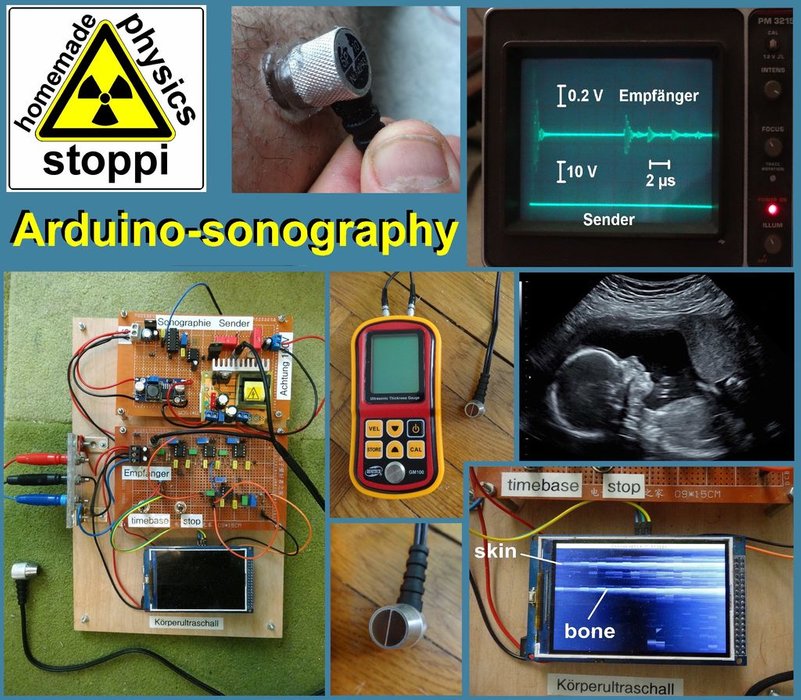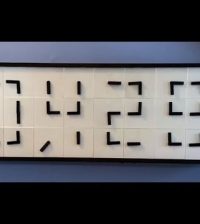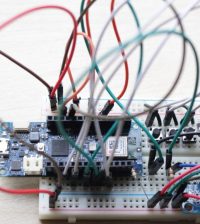- How to Adjust X and Y Axis Scale in Arduino Serial Plotter (No Extra Software Needed)Posted 7 months ago
- Elettronici Entusiasti: Inspiring Makers at Maker Faire Rome 2024Posted 7 months ago
- makeITcircular 2024 content launched – Part of Maker Faire Rome 2024Posted 9 months ago
- Application For Maker Faire Rome 2024: Deadline June 20thPosted 11 months ago
- Building a 3D Digital Clock with ArduinoPosted 1 year ago
- Creating a controller for Minecraft with realistic body movements using ArduinoPosted 1 year ago
- Snowflake with ArduinoPosted 1 year ago
- Holographic Christmas TreePosted 1 year ago
- Segstick: Build Your Own Self-Balancing Vehicle in Just 2 Days with ArduinoPosted 1 year ago
- ZSWatch: An Open-Source Smartwatch Project Based on the Zephyr Operating SystemPosted 1 year ago
Arduino-Sonography: Arduino-Based Ultrasound Machine

Inspired by a more complex and expensive project, Instructables member stoppi71 decided to create his own body-ultrasound machine using a 5 MHz ultrasound transducer via a paint-thickness gauge.
My hobby and passion is to realize physics projects. One of my last work is about ultrasonic sonography. As always I tried to make it as simple as possible with parts you can get on ebay or aliexpress. So let’s take a look how far I can go with my simple items…
Sonography is a very important way in medicine to look inside the body. The principle is simple: A transmitter sends ultra-sonic-pulses. They spread out in the body, are being reflected by inner organs or bones and come back to the receiver.
In my case I use the gauge GM100 for measuring the thickness of paint layers. Though not really intended for looking inside the body i am able to see my bones.
An Arduino Due provides computing power to turn sound pulses into images, while a 3.5-inch TFT display shows what it’s examining. Short pulses in the 100-200 nanosecond range are generated with the help of a monoflop and MOSFET, returning an echo corresponding to what it’s looking at.
Required components include:
- a gauge to measure the thickness of paint for 40 USD
- or just the 5 MHz transducer for 33 USD
- an arduino Due for 12 USD
- a 320×480 pixel display for 11 USD
- two 9V/1A power supplies for the symmetric +9/GND/-9V supply
- ultrasound-gel for sonography
for the transmitter:
- a step-up-converter for the needed 100V for 5 USD
- a common step-up-converter supplying 12-15V for the 100V-boost-converter for 2 USD
- a LM7805 voltage regulator
- monoflop-IC 74121
- mosfet-driver ICL7667
- IRL620 mosfet
- capacitors with 1nF (1x), 50pF (1x), 0.1µF (1x electrolytic), 47µF (1x electrolytic), 20 µF (1 x electrolytic for 200V), 100 nF (2x MKP for 200V
- resistors with 3kOhm (0.25W), 10kOhm (0.25W) and 50Ohm (1W)
- 10 kOhm potentiometer
- 2 pcs. C5-sockets: 7 USD C5 socket
for the receiver:
- 3 pcs. AD811 operational amplifie
- 1 pcs. LM7171 operational amplifie
- 5 x 1 nF capacitor, 8 x 100nF capacitor
- 4 x 10 kOhm potentiometer
- 1 x 100 kOhm potentiometer
- 0.25W resistors with 68 Ohm, 330 Ohm (2 pcs.), 820 Ohm, 470 Ohm, 1.5 kOhm, 1 kOhm, 100 Ohm
- 1N4148 diodes (2 pcs.)
- 3.3V zener diode (1 pcs.)















